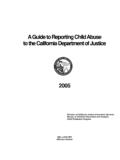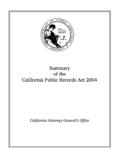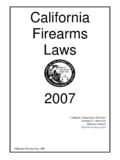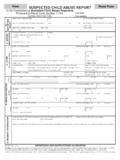Transcription of EDMUND G. BROWN JR. State of California Attorney General ...
1 EDMUND G. BROWN JR. State of California Attorney General DEPARTMENT OF JUSTICE State and Local Government Green Building Ordinances in California In recent years, California has taken the lead in promoting green building ordinances. These measures can increase energy efficiency, reduce greenhouse gas emissions, and decrease other harmful environmental impacts. Numerous local governments in California have implemented such measures, and in 2010, the State adopted the nation's first statewide green building standard. This document discusses the statewide code as well as the various approaches to green building ordinances that local jurisdictions have taken. CALGREEN Code The statewide code, known as CALGREEN Code (available here), applies to all new buildings constructed after January 1, 2011, and requires that they be built using environmentally advanced construction practices.
2 The Code updates Title 24 of the California Code of Regulations, also known as the California Building Standards Code. In addition to setting mandatory requirements, the Code includes more stringent optional provisions permitting developers to meet heightened standards, known as Tier 1 and Tier 2. CALGREEN Code (residential) and (nonresidential) include detailed criteria for meeting these tiers. Cities at their discretion may adopt Tier 1 or Tier 2 as mandatory or adopt and enforce other standards that are more stringent than the CALGREEN Code. The CALGREEN Code includes the following requirements: Mandatory Requirements Voluntary Standards Indoor Water Use 20% 30%; 35%; 40%. Reduction Water Meters Separate for nonresidential indoor and outdoor use Diversion of 50% Residential: 65% (Tier 1); 75%. Construction Waste (Tier 2). from Landfills Nonresidential: 65% (Tier 1).
3 80% (Tier 2). Mandatory Inspection Nonresidential buildings over of Energy Systems 10,000 ft.. Required Low- Paint, carpet, vinyl flooring, 80% VOC compliant resilient Pollutant Emitting and particle board flooring (Tier 1); 90% resilient Materials flooring (Tier 2). Energy Efficiency Exceed Title 24's 2008 Energy Efficiency Standard by 15%. (Tier 1); Exceed Standard by 30% (Tier 2). State Buildings In December 2004, Governor Schwarzenegger signed Executive Order S-20-04 (EO). The EO requires [d]esigning, constructing and operating all new and renovated State -owned facilities paid for with State funds as LEED Silver' or higher certified buildings. [LEED is discussed below.] The Department of General Services maintains an updated list of LEED State -owned facilities here: LOCAL GREEN BUILDING CODES. The following cities in California have enacted mandatory green building ordinances: City Ordinance Effective Date Link Albany Ord.
4 No. 06-016 July 2007 Here Brisbane Ord. No. 524 January 2008 Here Calabasas Ord. No. 2003-185 February 2004 Here Cotati Res. PC No. 06-24 January 2008 Here Culver City Ord. No. 2008-004 March 2008 Here Davis Ord. No. 2323 August 2008 Here Dublin Ord. No. 9-04 March 2004 Here Hayward Ord. No. 08-20 August 2009 Here Healdsburg Ord. No. 1079 August 2009 Here Livermore Ord. No. 1804 January 2008 Here Long Beach Ord. No. 09-0013 June 2009 Here Los Altos Ord. No. 07-315 December 2007 Here Los Altos Hills Ord. No. 512 November 2008 Here Los Angeles Ord. No. 179820 May 2008 Here Marin (Co.) Ord. No. 3533 June 2010 Here Mill Valley Ord. No. 1246 December 2008 Here Morgan Hill Ord. No. 1966 Ord. Pending Here Napa Ord. No. O2009 3 January 2009 Here Novato Ord. No. 1503 October 2005 Here Office of the California Attorney General Green Building Ordinances in California Page 2 of 11.
5 Oakland Ord. No. 12658 May 2005 Here Palm Desert Ord. No. 1124 February 2007 Here Palo Alto Ord. No. 5006 July 2008 Here Pasadena Ord. No. 7031 May 2008 Here Pleasanton Ord. No. 1934 January 2006 Here Redwood City Ord. No. 2348 November 2009 Here Rohnert Park Ord. No. 782 July 2007 Here San Francisco Admin. Bulletin January 2010 for Admin. Here No. AB-093 Implementing Bulletin and November Ord. No. 180-08 2008 for Ord. San Jose Ord. No. 28622 September 2009 Here San Mateo (Co.) Ord. No. 04411 March 2008 Here San Rafael Ord. No. 1879 June 2010 Here Santa Barbara Ord. No. 5446 March 2008 Here Santa Clara (Co.) Ord. No. August 2009 Here Santa Cruz Ord. 2005-29 January 2007 Here Santa Monica Ord. No. 2261 May 2008 Here Santa Rosa Ord. No. 3869 June 2008 Here Sebastopol Res. 5454 March 2005 Here Sonoma Ord. No. 03-2009 August 2009 Here Tiburon Ord.
6 No. 512 November 2008 Here Union City Ord. No. 729-10 2009 Here Windsor Ord No 2007-215 June 2007 Here West Hollywood Ord. No. 07-762 October 2007 Here Green Rating Systems The enactment of local green building requirements has been facilitated by the development of several independent rating systems increasingly used in the building industry to objectively evaluate green buildings. The most common system is Leadership in Energy and Environmental Design (LEED ), developed by the United States Green Building Council ( ). LEED has developed several rating systems with guidelines for different construction markets, including new nonresidential buildings, core and shell Office of the California Attorney General Green Building Ordinances in California Page 3 of 11. construction of commercial buildings, construction of commercial interiors, the construction of schools, health care facilities, and retail spaces, and a newly-developed system for homes (LEED-H), released in January of 2008.
7 The LEED for the Neighborhood Development Rating System (LEED-ND) launched in April 2009. LEED-ND integrates smart growth, urbanism, and green building at the neighborhood level to encourage the design of environmentally responsible communities. LEED-ND has three stages of certification: Conditionally Approved Plan, Pre-Certified Plan, and Certified Neighborhood Development. Under the LEED rating system, the use of specific green building practices or design elements, in addition to certain prerequisite practices, accrue points on a checklist. Depending upon the number of points earned, each project is given a rating which corresponds to a level of LEED certification. Projects which meet the minimum number of points are Certified. Projects which accrue more than the minimum are rated Bronze, . Silver, Gold, or Platinum, according to the number of points earned.
8 Most cities require some level LEED-equivalent performance for some types of buildings, but do not require registration with the United States Green Building Council. Another rating system used by local governments in their green building ordinances is the GreenPoints Rated . program first developed by a coalition of Alameda County waste agencies ( ) and promoted by Build It Green, a nonprofit organization based in Berkeley, California ( ). The GreenPoints Rated system, while similar in approach to LEED, is focused on residential development, including separate guidelines for single-family and multifamily buildings. A building must attain at least 50. GreenPoints to be certified as GreenPoint Rated.. Several cities or counties have developed their own points systems using guidelines and checklists based on the GreenPoint Rated system.
9 These include guidelines developed by the Sonoma County Waste Management Agency ( ) and the City of West Hollywood ( ). These alternative systems award points for many of the same practices, such as the use of fly ash in concrete, the recycling of construction debris, and the installation of overhangs. While the great majority of local ordinances require or permit the use of LEED ratings for public and commercial projects, most local ordinances rely on GreenPoints or related systems for residential construction. In 2007, Build it Green signed a Memorandum of Understanding with Davis Energy Group ( ) to calibrate the LEED for Homes and GreenPoints Rated systems for use in California , allowing for cross-training of building professionals, concurrent verification, and the possibility of dual-branded homes meeting the requirements of both systems.
10 Another alternative is the California Green Builder program ( ), developed by the California Building Industry Association's Building Industry. The California Green Builder program combines prescriptive green building measures with a performance-based verification system. Unlike LEED. and GreenPoints Rated, the California Green Builder protocols do not use points, but require specific practices and third party verification of a building's actual performance. The California Green Builder program requires that buildings exceed State energy efficiency requirements by at least 15%, while verifying practices such as duct sealing and construction waste management. As of yet, no California city has required developers to use the Green Builder Program. However, cities such as San Bernardino, Riverside, and Cathedral City have passed ordinances that provide incentives for developers who use the system.


















